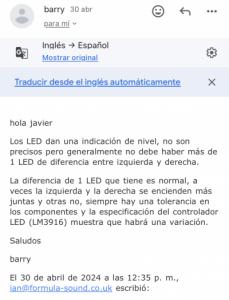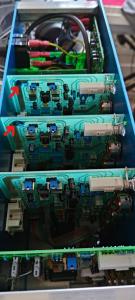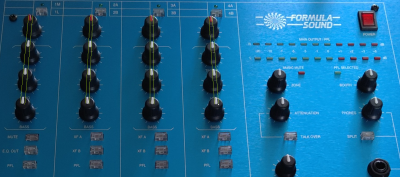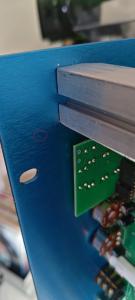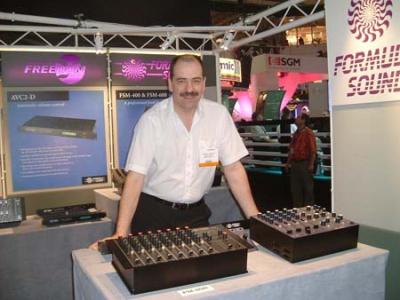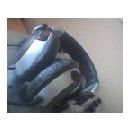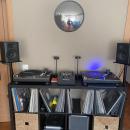Buenas,
Lo primero que estoy buscando una FSM400 15" blue, lo segundo que os voy a contar la historia de las formula sound actualmente, ya que compre en enero la ultima unidad que van a fabricar y los de UK han decidido hacer la devolucion del dinero.
He tenido una FSM600 desde el 2004 comprada nueva y ya detecte algunos fallitos, pero lo de la 400 se han sobrado, filtraciones de radio FM por los input riaa, hum del cable de alimentacion en algun canal, el paneo de los auriculares invertido, acabados penosos....
Atentos a las respuestas que no tienen desperdicio:
Alguien escribió:
Hi
1 Phones volume pot sounds dirty
This type of thing happens when equipment is not used for say a few months, pots start to set in position.
The mixer was tested before shipment so all pots were operated at that point so its not something that should have appeared after a week or so in transit, shipping can be rough so its possible the vibration of shipping had some similar effect. Has it happened since or or was it only there on first use ?.
2 Noise when power cable moved.
Should not be touching the power cable when its live, it carries mains power which potentially could be lethal so I would not do it. Any investigation like the video I would use an insulated clamp to hold the cable.
The natural position of the cable is between the PCB's, the cables own tension would not allow it to reach the position in the video where maximum pickup was observed. We will look at tying the cable in place, the noise floor is tested in several ways before shipment to ensure it meets specification.
The noise floor of any mixer is raised by any gain/amplification applied to it so testing at maximum volume will always increase the noise level.
3 Alignment of knobs
The knobs are hand fitted, they are push fit onto a spline shaft which means you get one chance to make them perfect because the spline cuts grooves in the inside of the knob, if you remove one and reseat it you will find it locates the grooves from the first fitting and so once fitted its either accept a tolerance or throw the knob away and fit another one.
I would say looking at the pictures the knobs on your mixer would be borderline accept/reject, we would need the mixer back to make a measurement to be certain if they are out of tolerance but they certainly are borderline. I will add we have been moving away from centre detent pots for this very reason, in real terms a 1mm offset on the pointer makes no difference because the settings of pots are to taste or for effect not a 1mm difference in the position of the pointer. For centre most use the feel of the detent rather than look at the pointer, the pointer becomes more important when there is no centre detent however even with no detent a 1mm error is not going to have a noticeable impact.
The biggest detriment is visual appearance.
4 Most annoying channels - I assume you mean most noise channels.
MIC and phono channels have lots of gain, the phono channel gain varies with frequency but is highest at low frequencies.
5 Master at max means more noise in phones
The phones out is master until a cue is pressed, so with no cue the noise from master will depend on master volume.
6 Floppy transformer.
The transformer should not be floppy, the fitting instruction should mean this should not happen.
7 The marks drawn in blue pen.
The front panel is checked to be blemish free, the reverse side which is mostly hidden can have a mark from assembly, these may be covered to seal the surface during production and as far as I can see this is what this is.
8 The second email showed pictures of the cover slightly bulging at the corners.
This is a tolerance issue, the mounting hole position in the front/rear panels together with the dimensions of the 4 support pillars together with the tolerance in the folded covers.
If the tolerance of each part on each side is 0.2mm then thats 3 x 0.2 = 0.6mm on one side and another 0.6mm on the other side adds up to 1.2mm in extreme, having looked at the stock it appears the covers need to be 0.6mm bigger to fit more comfortably.
9 Punch
The punch button has not changed in the sense that we use the same switch and button we always have, the panel dimensions are unchanged and the PCB is unchanged. What seems to have happened is the supplier of switch and button has slightly changed the button. Looking at the older buttons they do appear to be a slightly better fit and have a slightly different feel. It looks like the supplier has probably retooled the button and is using a slightly different material with the effect the button is slightly different size, I will investigate further.
I am sorry there are so many issues with your FSM400.
I will add the design is unchanged in 25 years, there are a significant number of things we would do better today for the same functionality, but what was very good 25 years ago is now more ordinary. That said your mixer certainly should not have had a floppy transformer.
You can either send the FSM400 back and we will address the issues, alternatively you can send it back later.
I hope I have answered all your questions, email me again if I have not.
Regards
Barry Penaligon
Formula Sound Ltd
Y tras esperar 7 meses pensando que iban a poder hacer algunas mejoras, me responde esta maravilla....
Alguien escribió:
Hi
The FSM400 was returned from Thomman, we had to inform them it was not economic to fix the mixer and that FSM400 was the end of production so we could not do a replacement and the only option was refund, so hopefully you have received a refund from the vendor you purchased it from which I presume was Thomman.
The cover bulging was due to slightly incorrect production of the covers, the covers we had in stock were the same so we would have had to purchase a batch of 50 to get replacement covers.
The mark on the back of the FSM400 faceplate would require another faceplate, again we would have to purchase a batch of 50.
The knob alignment and headphone left and right were possible to deal with.
The gain structure of the FSM400 is unchanged from the original, the full gains are high and the intention was the user would set to their requirement, the downside is the gains gain be set very high to levels that are unusable with a signal but without a signal the noise floor starts to become audible. Changing the gain structure is possible but would require a days work to test.
The LED's being picked up in the headphones at high volumes and depending on cable position is an unresolved issue from the original design and is present on the FSM600, generally the headphones are not operated at the level that picks up noise from the LEDs because with music its just too loud.
I am not sure if the last FSM400 was a bit worse than it usually is but we had a customer about 2 years ago that identified it and when we investigated we found it was detectable in the FSM600 also and that it was present for the original design so we accept there is an issue.
Fixing the LED breakthrough to headphones would require perhaps 2 weeks engineering work and even then we could not be certain more time might be needed.
The XLR's not gripping, the XLR used is an obsolete XLR and no longer manufactured, we have been using stock and the remaining stock is as those fitted, we believe there was a XLR that matched the XLR in the unit which is also obsolete however we cannot rule out the XLR's fitted and our stock is actually defective but its the only XLR that will fit the PCB so its not a fixable issue.
We had already decided to discontinue the FSM400 and the one you ordered was to be the last, the cost of fixing would be up to £4000 in engineering time, test time etc which is not economic so we relayed this to thomman.
Regards
Barry
Menudos personajes, encima que dedico tiempo para mejorar su producto
Aun asi sigo buscando una FSM400 de las primeras, que al fin y al cabo el sonido esta ahi y ya apañare los fallos que tengan.






